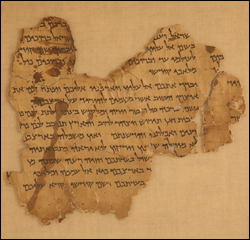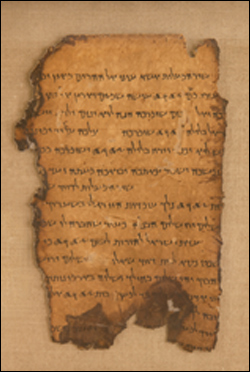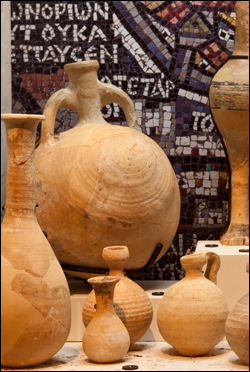|
It was probably the worst time to have to deal with ancient manuscripts. In 1947, a Bedouin shepherd tossed a stone into a cave close to the northwest shore of the Dead Sea, in Qumran. Rather than the sound of rock or earth, he heard the sound of breaking pottery. Peering into the cave, he saw a number of tall clay jars. Together with a cousin, he entered the cave where he found one jar containing some scrolls. The two began showing them to people, looking for a buyer. Eventually, they sold some of the scrolls to Kando, a local cobbler who dealt in antiques. As word of the scrolls spread, institutional buyers became interested.

One of the Dead Sea Scrolls.
Although hostilities between the Jews of the area and Arabs were obviously imminent, archaeologist Eliezer Sukenik managed to buy three for the Hebrew University. The head of the Syrian Orthodox Church in Jerusalem, Mar Athanasius Samuel, purchased the remaining four.
The scrolls, which would turn out to be some of the most famous archaeological finds of all time, sold for negligible amounts. The original Bedouin finders got less than $35 for the set. Samuel smuggled his four scrolls to America and placed an advertisement in the Wall Street Journal offering the scrolls as an “ideal gift to an educational or religious institution.” And who wouldn’t want a gift of a priceless ancient manuscript?
Because of the political situation in the Middle East, Jewish scholars could not directly approach Samuel to purchase the scrolls. Professor Harry Orlinsky from Hebrew Union College, calling himself Mr. Green, dealt with Samuel, eventually purchasing the scrolls on behalf of archaeologist Yigael Yadin, the son of Eliezer Sukenik, for $250,000, which would be over $2 million today. The scrolls were brought back to the Rockefeller Museum in East Jerusalem, where they remained under Jordanian control until the Six Day War.
Following the Bedouin Shepherd’s discovery, Qumran area saw a gold rush of sorts, as archaeologists vied with local tribesmen to recover the leather fragments from nearby caves. In total, 972 documents were found in 11 local caves.
The Dead Sea Scrolls include three types of documents: the earliest existing copies of books from the Hebrew Bible, known in Hebrew as the Tanach; copies of other early works that are not part of Tanach; and works related to a specific sect that existed among the Jews at the time of the Second Temple in Jerusalem. There were also ancient tefillin scrolls and archaeological artifacts, such as mikvahs, ritual baths.
The Dead Sea Scroll Scholar
Professor Lawrence Schiffman, a tall, genial man, with a pronounced New York accent and an infectious sense of humor, was recently appointed Vice-Provost of Undergraduate Education at Yeshiva University. Previously, he worked at New York University for 39 years, where he was chair of the Skirball Department of Hebrew and Judaic Studies.
Schiffman has been working on the Dead Sea Scrolls ever since he was a senior in college. In fact, even his doctorate was on the Scrolls, although at that time not all of the Scrolls had been published or were available for study.
The professor explained that middle-east politics delayed the Scrolls’ publication. “First, some scrolls were found before the ’48 war. But then there were a tremendous number of fragments found in the ‘50s in Qumran, which was then part of Jordan. In ’67, Israel took control of East Jerusalem, where these unpublished fragments lay at the Rockefeller Museum.
“The problem was that the Israelis gave the job of publication to a team of Christian scholars who kept saying, ‘We’re almost done, we’re almost done, we’re almost done.’ That deal turned out to be a mistake. It was clear that they just weren’t doing it. The Israeli government overturned the whole arrangement in 1990, and within a short time the Scrolls were published and exhibited. I was a member of the new publication team.”
Schiffman first discovered the scrolls when he was studying Bilical history at Brandeis University in Boston, MA, when someone suggested, “Why don’t you try the Dead Sea Scrolls?”
According to Schiffman, “Besides for a few Israelis here or there, most of the work was being done by people who had no real training in Jewish texts. They might have had training in Bible, taught from either an academic or Christian point of view, but they knew nothing about Rabbinic Judaism, Jewish law or Talmud.”
Professor Schiffman explained that study of the Scrolls usually doesn’t involve study of the physical objects themselves. “There is a stage where you need the physical scrolls, because of letters around the edge or other things like that. But mostly, the photos are much better, because of the use of infrared technology. Some of the Scrolls have become completely brown and are not decipherable to the naked eye.”
Unfortunately, the original work on the Scrolls actually caused a great deal of damage to the fragile parchment. Scholars smoked while studying the fragments and taped them together using regular tape. Part of the ongoing conservation work merely seeks to reduce the damage done by scholars of the past, who may have destroyed more in a few years than had been lost over the previous 2,000. As such, access to the Scrolls is quite limited.
How to View the Scrolls

One of the Dead Sea Scrolls.
Schiffman explained that the scholarly approach to the Scrolls has changed with time. Originally, “They analyzed the Scrolls as proto-Christianity.” But the approach to the Scrolls in recent years has become much more nuanced, he said. “Younger scholars understand that they need to be familiar with the history of Judaism during the Second Temple era to understand later developments.”
For example, many scholars think that the Qumran sect believed in celibacy. “I personally don't agree with that interpretation,” says Schiffman, “but even if you do, there are two ways to look at it.” Previously, scholars interpreted it as proto-Christianity, however, “If you come at it objectively, you can try to figure out if there were some Jews who thought celibacy was a good idea in the pre-Christian period, and why they might have thought that.”
Schiffman sees the Scrolls as a valuable repository of information about Jewish life and thought during the era of the Second Holy Temple.
“My focus is predominantly on how the Scrolls fit into the history of Judaism and what they tell us about the Second Temple period. Until the Scrolls were discovered, we relied on the book of Josephus and the book of Maccabees. The Scrolls give us a tremendous amount of further information about that period.
“People like to discuss which sect originally compiled the Scrolls. Most scholars attribute them to the Essenes, described by Josephus. But irrespective of that, from my point of view, I’m not so interested in the people who gathered the Scrolls. I’m more interested in the contents of the Scrolls, because they shed light on the beliefs of all the Jews of the time.”
Interesting For Jews?
I asked Professor Schiffman what the average Jew can find of interest in the Scrolls.
“There is an emotional component,” the expert explained, pointing to a piece of Psalm 121 on display, “esa einei el he’harim,”–“I shall raise my eyes to the mountains…”
“When you realize that these very words were recited directly from this scroll by our forefathers 2,200 years ago, it’s very moving.”
Schiffman added that he finds that Jews generally have an intense interest in archaeology and their history.
According to Schiffman there are certain differences between books ofTanach found in the Dead Sea Scrolls and those that we have.
“There are some texts that are slightly different, usually just in the spelling of a word here or there.” He explained that ultimately the differences were expunged; a scroll found in the courtyard of the Holy Temple, “corrected all the other texts.”
More to Investigate?

Jugs found in Qumran.
I asked Professor Schiffman, “You have a finite number of scrolls that have all been found and published. What is there still to investigate?”
He explained, “Until recently the main task involved editing and publishing the Scrolls. But now, the research possibilities are endless.
“For example, one of the fundamental ideas in Jewish mysticism is that the angels praise G‑d in Heaven. When you open up the Dead Sea Scrolls, there are poems, not the same poems we have, and they describe the angelic praise of G‑d.”
“So now, if a person were to write a book about angelic praise of G‑d in Judaism, they have a wider resource field available.”
PART. 2
|